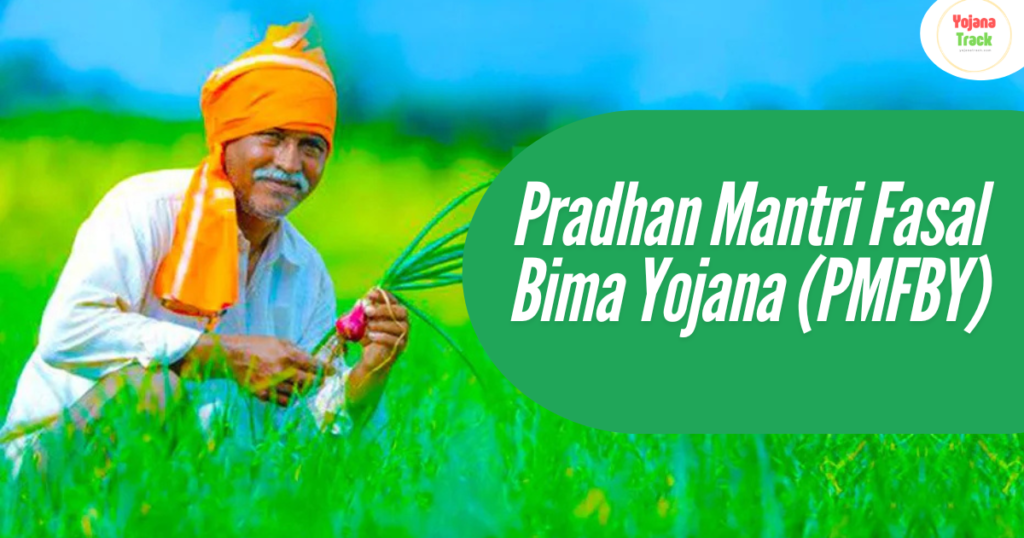The Government of India launched the Pradhan Mantri Fasal Bima Yojana (PMFBY) as a flagship program to give farmers full insurance coverage in the case of crop failure. Launched on January 13, 2016, this scheme aims to stabilize farmers’ incomes, encourage innovation in agriculture, and ensure food security across the nation.

What is Pradhan Mantri Fasal Bima Yojana (PMFBY)?
PMFBY is an agriculture insurance scheme designed to protect farmers from financial losses due to crop failures caused by natural calamities, pests, and diseases. The scheme integrates the use of technology for accurate crop yield assessments and fast claim settlements, ensuring farmers receive timely support.
Objectives of Pradhan Mantri Fasal Bima Yojana
- Risk Mitigation – PMFBY offers financial protection against unforeseen risks and disasters.
- Farmer Empowerment – It encourages farmers to adopt advanced agricultural practices by providing them with a safety net.
- Income Stability – The scheme aims to stabilize farmers’ incomes, ensuring they continue agricultural activities despite adverse climatic conditions.
- Increased Credit Flow – It facilitates access to institutional credit for farmers by protecting their investments.
- Boosting Productivity – By reducing financial risks, PMFBY motivates farmers to invest in better technology and inputs.
Key Features of PMFBY
- Affordable Premiums: Farmers pay a nominal premium rate – 2% for Kharif crops, 1.5% for Rabi crops, and 5% for commercial/horticulture crops. The remaining premium is subsidized by the government.
- Comprehensive Coverage: PMFBY covers prevented sowing, post-harvest losses, localized calamities, and widespread natural disasters.
- Use of Technology: Satellite imagery, drone technology, and remote sensing are employed to assess crop damage accurately.
- Timely Claims: PMFBY ensures quick disbursement of claims to minimize farmers’ financial distress.
- Inclusion of All Farmers: The scheme is open to all farmers, including sharecroppers and tenant farmers.
- Cluster Approach: States adopt a cluster approach by inviting insurance companies to bid for clusters of districts, ensuring greater efficiency and competition.
Who Can Avail PMFBY?
- Loanee Farmers – Farmers who have availed seasonal agricultural loans from financial institutions are automatically enrolled.
- Non-Loanee Farmers – Farmers without institutional credit can voluntarily apply by submitting relevant documents.
- Sharecroppers and Tenant Farmers – These groups are also eligible under specific conditions.
Crops Covered Under PMFBY
- Food Crops: Rice, wheat, maize, pulses, etc.
- Commercial Crops: Cotton, sugarcane, jute, etc.
- Horticultural Crops: Vegetables, fruits, and other horticultural crops.
Premium Structure and Subsidy
The premium rates under PMFBY are kept affordable to ensure wider coverage.
- Kharif Crops: 2% of the sum insured.
- Rabi Crops: 1.5% of the sum insured.
- Commercial/Horticultural Crops: 5% of the sum insured.
The government subsidizes the rest of the premium to ease the financial burden on farmers.
How to Apply for PMFBY?
Online Application Process:
- Visit the Official PMFBY Website: https://pmfby.gov.in
- Register/Login: Farmers need to create an account or log in.
- Enter Details: Fill in personal details, land information, and crop details.
- Submit Documents: Upload necessary documents such as land records and proof of sowing.
- Pay Premium: Make the payment online.
- Confirmation: Receive acknowledgment and confirmation of insurance coverage.
Offline Application Process:
- Visit the Nearest Bank/CSC: Farmers can apply through banks or Common Service Centers (CSCs).
- Submit Application Form: Fill out the form and submit necessary documents.
- Pay Premium: Pay the required premium.
- Acknowledgment: Receive a receipt and insurance details.
Claim Process Under PMFBY
- Notification of Crop Damage: Farmers must inform authorities within 72 hours of the event.
- Field Assessment: Local officials conduct a field assessment to evaluate the damage.
- Claim Processing: The insurance company processes the claim based on the assessment.
- Disbursement of Claims: Approved claims are transferred directly to the farmer’s bank account.
Benefits of PMFBY
- Financial Security: Farmers are protected against economic losses due to crop failures.
- Comprehensive Coverage: PMFBY covers a wide range of risks, ensuring holistic protection.
- Improved Agricultural Practices: With risk mitigation, farmers invest in better technology and inputs.
- National Food Security: By safeguarding farmers’ incomes, PMFBY promotes continuous agricultural production.
Challenges and Solutions in PMFBY Implementation
Challenges:
- Delayed Claim Settlements – In some cases, claims have been delayed.
- Lack of Awareness – Some farmers are unaware of the scheme and its benefits.
- Assessment Discrepancies – Field assessments may lead to disputes regarding damage evaluation.
Solutions:
- Technology Integration – Use of AI, drones, and remote sensing ensures accurate assessments.
- Awareness Campaigns: To educate farmers, governments run awareness and training initiatives.
- Streamlined Processes – Digitization and online platforms have expedited the claim process.
Conclusion
Pradhan Mantri Fasal Bima Yojana (PMFBY) is a transformative initiative that empowers farmers by mitigating risks and ensuring income stability. By leveraging technology and fostering inclusivity, PMFBY plays a pivotal role in enhancing India’s agricultural resilience.